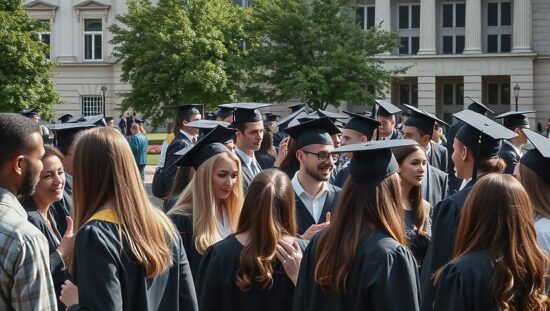The number of graduates from German universities and research institutions reached approximately 511,600 in the 2024 examination year, according to data released by the Federal Statistical Office (Destatis). This represents a 1.9 percent increase compared to the 501,900 graduates in 2023. The most significant proportional increases were observed in doctoral degrees and qualifications for teaching positions.
Bachelor’s degrees accounted for almost half (48 percent, or 245,600) of all examinations completed in 2024. This figure demonstrates a slight rise of 0.8 percent compared to 2023 when 243,600 bachelor’s degrees were awarded. Simultaneously, the number of Master’s degrees (excluding teacher training) increased by 1.9 percent to 149,300, up from 146,500 in the previous year. Master’s degrees maintained a 29 percent share of all degrees awarded overall.
Approximately one in ten degrees (10 percent, or 49,700) in 2024 were related to teacher training. This breakdown included 19,100 bachelor’s degrees, 20,200 Master’s degrees and 10,400 state examination degrees. The combined number of Master’s and state examination degrees qualifying for teaching positions saw a 5 percent increase from the prior year, rising from 29,000 to 30,600.
Doctoral degrees constituted 28,200 degrees, or 6 percent of all qualifications awarded in 2024; this marks a 6 percent increase compared to the 26,600 doctoral degrees conferred in 2023. This represents the largest proportional increase amongst any degree category.
Further distinctions include 31,000 conventional university and artistic degrees (such as state examinations outside of teaching and university diplomas) and 7,800 conventional university of applied sciences degrees (for instance, a degree from a Fachhochschule).
Analyzing degrees by subject area reveals that 41 percent of qualifications in 2024 fell within the fields of Law, Business and Social Sciences. Engineering accounted for 25 percent of degrees awarded. Mathematics, Natural Sciences and the Humanities comprised 11 percent and 9 percent respectively. The fields of Human and Health Sciences accounted for 7 percent of all degrees. The remaining percentages were distributed amongst other subject groups including sports science, agricultural, forestry and nutrition sciences, veterinary medicine and the arts.





